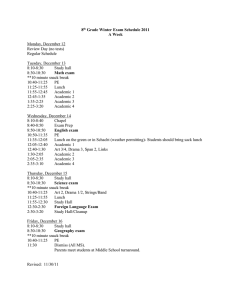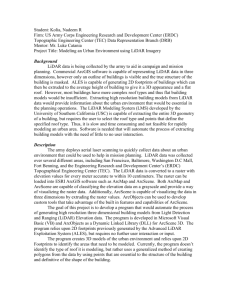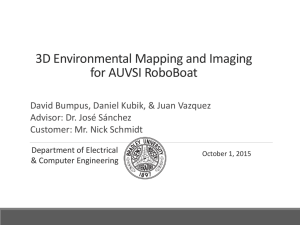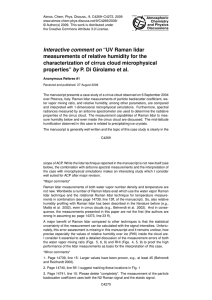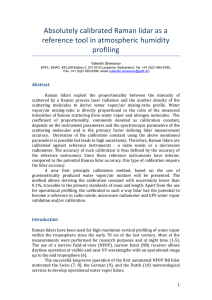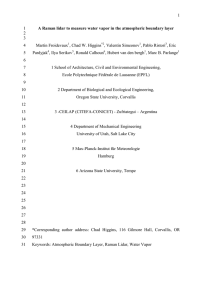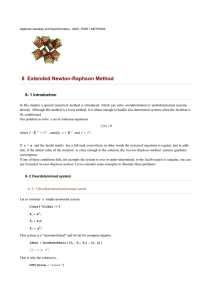LASER RADAR SYSTEMS OPTICAL REMOTE SENSING PROBLEM 1: LINK-BUDGET (ELASTIC-BACKSCATTER LIDAR)
advertisement
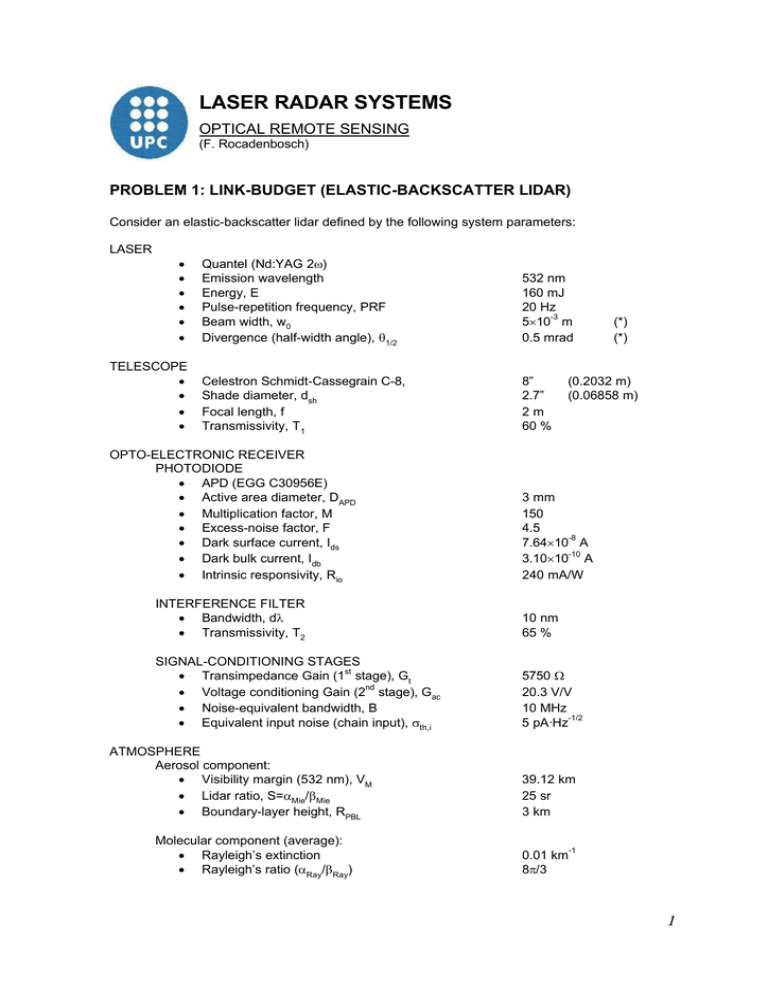
LASER RADAR SYSTEMS OPTICAL REMOTE SENSING (F. Rocadenbosch) PROBLEM 1: LINK-BUDGET (ELASTIC-BACKSCATTER LIDAR) Consider an elastic-backscatter lidar defined by the following system parameters: LASER • • • • • • TELESCOPE • • • • Quantel (Nd:YAG 2ω) Emission wavelength Energy, E Pulse-repetition frequency, PRF Beam width, w0 Divergence (half-width angle), θ1/2 532 nm 160 mJ 20 Hz 5×10-3 m 0.5 mrad Celestron Schmidt-Cassegrain C-8, Shade diameter, dsh Focal length, f Transmissivity, T1 8” 2.7” 2m 60 % OPTO-ELECTRONIC RECEIVER PHOTODIODE • APD (EGG C30956E) • Active area diameter, DAPD • Multiplication factor, M • Excess-noise factor, F • Dark surface current, Ids • Dark bulk current, Idb • Intrinsic responsivity, Rio (0.2032 m) (0.06858 m) 3 mm 150 4.5 7.64×10-8 A 3.10×10-10 A 240 mA/W INTERFERENCE FILTER • Bandwidth, dλ • Transmissivity, T2 10 nm 65 % SIGNAL-CONDITIONING STAGES • Transimpedance Gain (1st stage), Gt nd • Voltage conditioning Gain (2 stage), Gac • Noise-equivalent bandwidth, B • Equivalent input noise (chain input), σth,i 5750 Ω 20.3 V/V 10 MHz -1/2 5 pA·Hz ATMOSPHERE Aerosol component: • Visibility margin (532 nm), VM • Lidar ratio, S=αMie/βMie • Boundary-layer height, RPBL Molecular component (average): • Rayleigh’s extinction • Rayleigh’s ratio (αRay/βRay) (*) (*) 39.12 km 25 sr 3 km 0.01 km 8π/3 -1 1 Background-radiance component • Moon’s radiance (full Moon), LMoon • Solar radiance, LSun (typ.) 3×10-11 W·cm-2·nm-1·sr-1 3×10-6 W·cm-2·nm-1·sr-1 OTHER PARAMETERS • Full-overlap range, Rovf • Maximum-range criterion 200 m SNR(Rmax) =1 PHYSICAL CONSTANTS • Electron charge, q • Planck’s constant, h • Light speed, c • Boltzmann’s constant, K 1.602×10-19 C 6.6262×10-34 J·s 2.99793×108 m·s-1 1.38×10-23 J·K-1 (*) (*) Parameter not used. Questions: 1. Determine the system constant, K(λ) [W·km3] 2. Estimate the received background power under night-time operation, Pback 3. Compute and plot the return power at the following ranges: a. P(0.2 km) b. P(1 km) c. P(2 km) d. P(3 km) e. P(3+ km) f. P(4 km) 4. Compute the receiver-chain voltage responsivity, Rv, and the net voltage responsivity (i.e., including spectral optical losses), Rv’. 5. a) Compute the range-dependent signal-to-noise ratio (consider the ranges of question 3), SNR(R). b) Identify the noise-dominant system-operation mode. 6. Assess the approximate laser-radar maximum range. 7. How many pulses are needed to integrate in order to ensure a SNRv (voltage signal-tonoise ratio) of 40 dB at 3-km range? What is the resulting observation time of the lidar instrument? 8. Now, consider a Raman system of similar specs. If for Raman systems the return signal is typically 3 orders of magnitude lower than for their elastic system counterparts, discuss on the feasibility of day-time operation. 9. Compute the photodiode NEP and its quantum efficiency (η). 10. Compute the system NEP (NEPs). 2 SOLUTIONS 1. K(532 nm)=6.89×10-4 W·km3 2. Pback = 1.52×10-13 W 3. P(0.2 km)=8.56×10-5 W, P(1 km)=2.87×10-6 W, P(2 km)=5.76×10-7 W, P(3 km)=2.06×10-7 W, P(3+ km)=4.72×10-8 W, P(4 km)=2.60×10-8 W 4. Rv=4.20×106 V/W, Rv’=1.64×106 V/W 5. SNRv(0.2 km)=57.5 dB, SNRv(1 km)=42.7 dB, SNRv(2 km)=35.7 dB, SNRv(3 km)=31.3 dB, SNRv(3+ km)=24.9 dB, SNRv(4 km)=22.3 dB 6. Rmax ≈ 16.9 km 7. ni=8 pulses, tobs=0.4 s 8. The Raman lidar cannot be operated day-time because P(0.2 km)=8.56×10-8 W is progressively comparable to the background component, Pback=1.52×10-8 W, as we move further in range. 9. NEP=88.2 fW·Hz-1/2, η=55.9 % 10. NEPs=422 fW·Hz-1/2 3

